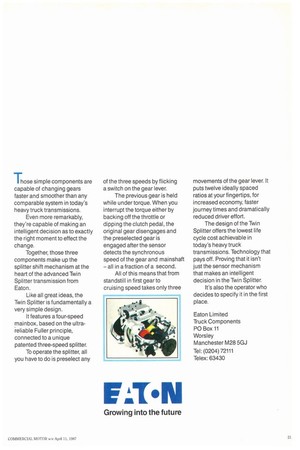T hose simple components are capable of changing gears faster and smoother than any comparable system in today's heavy truck transmissions.
Page 23

If you've noticed an error in this article please click here to report it so we can fix it.
Even more remarkably, they're capable of making an intelligent decision as to exactly the right moment to effect the change.
Together, those three components make up the splitter shift mechanism at the heart of the advanced Twin Splitter transmission from Eaton.
Like all great ideas, the Twin Splitter is fundamentally a very simple design.
It features a four-speed main box, based on the ultrareliable Fuller principle, connected to a unique patented three-speed splitter.
To operate the splitter, all you have to do is preselect any of the three speeds by flicking a switch on the gear lever.
The previous gear is held while under torque. When you interrupt the torque either by backing off the throttle or dipping the clutch pedal, the original gear disengages and the preselected gear is engaged after the sensor detects the synchronous speed of the gear and mainshaft — all in a fraction of a second.
All of this means that from standstill in first gear to cruising speed takes only three movements of the gear lever. It puts twelve ideally spaced ratios at your fingertips, for increased economy, faster journey times and dramatically reduced driver effort.
The design of the Twin Splitter offers the lowest life cycle cost achievable in today's heavy truck transmissions. Technology that pays off. Proving that it isn't just the sensor mechanism that makes an intelligent decision in the Twin Splitter.
It's also the operator who decides to specify it in the first place.




























































































